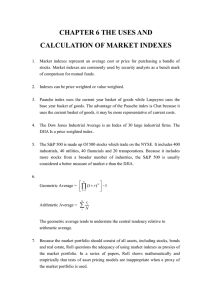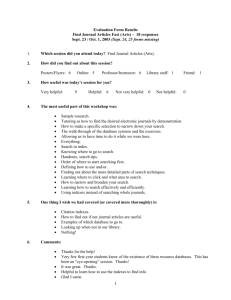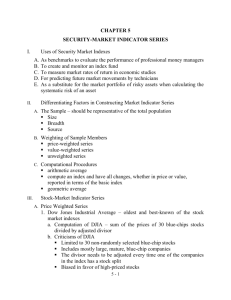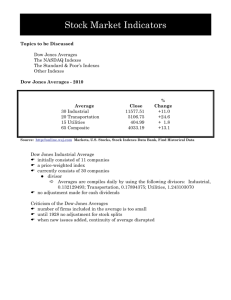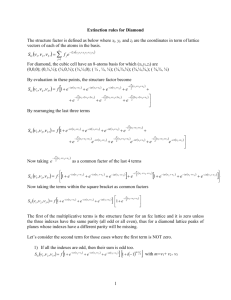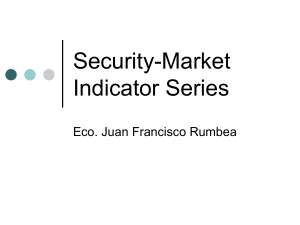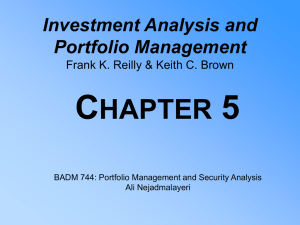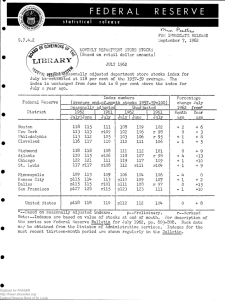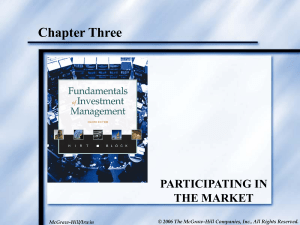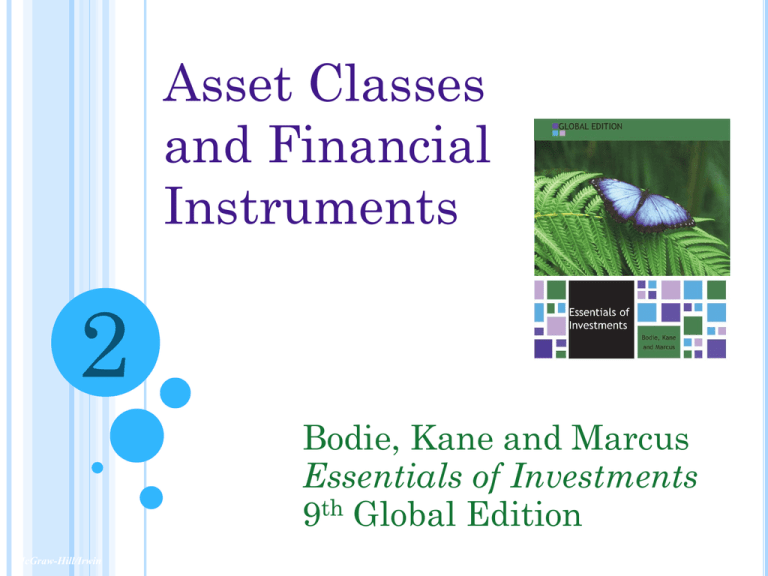
Asset Classes
and Financial
Instruments
2
Bodie, Kane and Marcus
Essentials of Investments
9th Global Edition
McGraw-Hill/Irwin
Copyright © 2013 by The McGraw-Hill Companies, Inc. All rights reserved.
2.4 STOCK AND BOND MARKET INDEXES
Uses
Track average returns
Compare performance of managers
Base of derivatives
Factors in constructing/using index
Representative?
Broad/narrow?
How is it constructed?
2.4 STOCK AND BOND MARKET INDEXES
Construction of Indexes
How are stocks weighted?
Price weighted (DJIA)
Market value weighted (S&P 500,
NASDAQ)
Equally weighted (Value Line Index)
How much money do you put in each stock in the
index?
2.4 STOCK AND BOND MARKET INDEXES
Constructing Market Indexes
Weighting schemes
Price-weighted average: Computed by
adding prices of stocks and dividing by
“divisor”
Market value-weighted index: Return
equals weighted average of returns of each
component security, with weights
proportional to outstanding market value
Equally weighted index: Computed from
simple average of returns
2.4 STOCK AND BOND MARKET INDEXES
Price-Weighted
Series
Stoc
k
Price
Quantity
B
B
P1
Q1
A
$10
40
$15
40
B
50
80
25
160
C
140
50
150
50
Time 0 index value: (10 + 50 + 140)/3 = 200/3 = 66.7
Time 1 index value: (10 + 25 + 140)/Denom = 66.67
Denominator = 2.624869
Time 1 index value: (15 + 25 + 150)/2.624869 = 72.38
Other problems:
•
•
•
•
•
•
•
Similar % change movements in higher-price stocks cause proportionally
larger changes in the index
Splits arbitrarily reduce weights of stocks that split in index
2.4 STOCK AND BOND MARKET INDEXES
Stoc
k
•
Price
Quantity
B
B
P1
Q1
A
$10
40
$15
40
B
50
80
25
160
C
140
50
150
50
Value-Weighted Series
IndexV = (15 40) (25 160)
(150 50)
(10 40) (50 80) (140 50)
•
100 106.14
Equal-Weighted Series
•
wlog invest $300 in each
IndexE =
(15 30) (25 1 2 ) (150 2 . 143 )
(10 30) (50 6) (140 2 . 143 )
100 119.05
2.4 STOCK AND BOND MARKET INDEXES
Case 1
Stock
•
PB
QB
P1
Case 2
Q1
P1
Q1
A
$10
40
$12
40
$10
40
B
100
80
100
80
100
80
C
50
200
50
200
60
200
Why do the two differ?
•
Case 1: 20% change in price of small-cap firm
IndexV =
•
(12 40) (100 8 0) (50 20 0)
(10 40) (100 80) (50 200)
100 100.43
wlog invest $100 in each stock
IndexE =
(12 10) (100 1) (50 2)
(10 10) (100 1) (50 2)
100 106.67
2.4 STOCK AND BOND MARKET INDEXES
Case 1
Stock
•
PB
QB
P1
Case 2
Q1
P1
Q1
A
$10
40
$12
40
$10
40
B
100
80
100
80
100
80
C
50
200
50
200
60
200
Case 1 VW = 100.43
Case 1 EW = 106.67
Why do the two differ?
•
Case 2: 20% change in price of large-cap firm
IndexV =
•
(10 40) (100 8 0) (60 20 0)
(10 40) (100 80) (50 200)
100 110.86
Assume $100 investment in each stock
IndexE =
(10 10) (100 1) (60 2)
(10 10) (100 1) (50 2)
100 106.67

